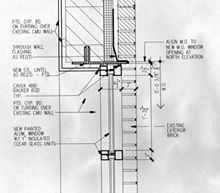 Aluminum frames make attractive windows and doors in masonry buildings. Inset shows a close-up of a joint filled with caulk between the frame and masonry wall.
Aluminum frames make attractive windows and doors in masonry buildings. Inset shows a close-up of a joint filled with caulk between the frame and masonry wall.
Architectural aluminum is widely used for window and door frames because it is attractive, durable, and requires little maintenance (see Fig. 1 and inset). However, unprotected aluminum interacts with cement-based materials, sometimes resulting in severe frame damage. This article provides guidance for protecting aluminum frames from mortar used in masonry walls.
In fresh concrete, aluminum reacts principally with alkali hydroxides from cement. The pH of fresh mortar ranges from 12 to 13. Aluminum in contact with plain concrete can corrode, and the situation is worse if the concrete contains calcium chloride as an admixture or if the aluminum is in contact with a dissimilar metal.
Ensuring a good quality installation of aluminum-framed windows and doors includes proper material selection and correct construction practices.
Materials
 This cut-away section of a masonry wall is a typical construction detail, which includes a gap for caulk all around the frame.
This cut-away section of a masonry wall is a typical construction detail, which includes a gap for caulk all around the frame.
The American Architectural Manufacturers Association recommends using only coated windows for installations involving any cement-based materials, including masonry. The coating materials may be either organic, such as paint, or inorganic, such as anodized aluminum. Currently, organic-type coatings are the most widely used finishes for architectural aluminum. For exterior use, the AAMA recommends high-performance coatings (fluorocarbons, siliconized acrylics, siliconized polyesters) that are capable of weathering outdoor exposure for at least 20 years.
Some coatings are only able to protect up to a pH of about 11. Fresh mortar can stain frames coated with these materials, and if allowed to rest on the frame, the mortar can also lead to corrosion or other surface damage. To prevent this, fresh mortar droppings should be removed as quickly as possible from aluminum frames.
Organic coatings on extruded aluminum window and door frames are categorized as pigmented, high performance, and superior performing coatings. For light commercial and residential applications, the "pigmented" category is acceptable. The coating should be at least 20 microns thick. Chemical resistance of the organic finishes is sufficient to withstand the mild cleaners (acid or alkaline) or other corrosives associated with the construction process or cleanup. AAMA Standards 2603, 2604, and 2605 provide test methods and performance criteria (including chemical resistance and corrosion resistance) for pigmented, high performance, and superior performing organic coatings, respectively.
Inorganic coatings, such as anodized finishes, convert the outer layer of aluminum to aluminum oxide, producing an extremely durable surface. Applying a clear (organic) coating can further protect the anodized surface. To prevent staining, alkaline building materials such as wet mortar, plaster, or concrete should be removed quickly from anodized surfaces.
Construction
Masonry walls should be built well in advance of inserting frames into the wall to protect aluminum. This allows time for the mortar to cure and dry, which reduces the movement of alkalies. The frame is then attached with screws at the bottom, top, and sides (see Fig. 2).
 A 1/2-inch gap should be left around the frame. When filled with caulk, this gap separates the inside of the building from the outside, reduces wall stresses acting on the frame, and creates a barrier between the mortar and the window/door frame material. Even so, (new) hardened mortar that is rewetted by precipitation can still be a source of alkalies. Good coatings should adequately protect aluminum from chemical attack. Two coats of bituminous paint or zinc chromate primer are often used in severe applications to provide separation of the aluminum from the cement-based products. A light coating of petroleum jelly painted onto the surface of the frame is another way to provide temporary protection to the finish during construction.
A 1/2-inch gap should be left around the frame. When filled with caulk, this gap separates the inside of the building from the outside, reduces wall stresses acting on the frame, and creates a barrier between the mortar and the window/door frame material. Even so, (new) hardened mortar that is rewetted by precipitation can still be a source of alkalies. Good coatings should adequately protect aluminum from chemical attack. Two coats of bituminous paint or zinc chromate primer are often used in severe applications to provide separation of the aluminum from the cement-based products. A light coating of petroleum jelly painted onto the surface of the frame is another way to provide temporary protection to the finish during construction.
Anything that directs moisture away from the frame reduces alkali exposure. Therefore, if it is possible to separate the frame from direct contact with the mortar by a sheet material (flashing), this can help reduce corrosion as well. Plastics, rubbers, and vinyl materials resistant to UV degradation and attack by alkalies are all acceptable.
If the masonry wall is to be cleaned following construction, the aluminum must not be subjected to harsh chemicals and must be rinsed thoroughly. Clear water should remove any products used to clean the wall and any alkalies washed off the building face.
For specifications and other information on aluminum coatings, visit American Architectural Manufacturers Association.
Protecting Aluminum Frames in Masonry Walls
- Choose coatings for resistance to high pH.
— Thicker coatings are generally better.
— Organics are usually more resistant than non-organics (anodized coatings).
— Temporary coatings (plastic film, paper, cloth, or petroleum jelly) can provide protection during construction. - Place aluminum frames into walls after mortar has cured.
- Separate frame and masonry with a caulk gap.
- Remove fresh mortar from aluminum frames as quickly as possible.
- Direct water away from the wall with drips and flashings.